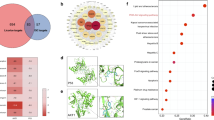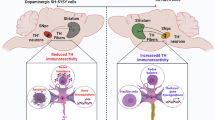Abstract
Chrysoeriol, a dietary methoxyflavonoid which is found in tropical medicinal plants, has been shown to have antioxidant, anti-inflammatory, and antineoplastic properties. The present study aimed to investigate the effects of chrysoeriol and its related mechanisms in rat C6 glioma cells. Cell viability in rat C6 glioma cells were measured by MTT assay. The protein expression levels of cleaved caspase-3, caspase-3, pro-apoptotic (Bax), anti-apoptotic protein (Bcl-2), and Annexin V were detected by Western blot analysis and immunocytochemical staining. Results showed that chrysoeriol significantly decreased cell viability and induced apoptosis in rat C6 glioma cells. Chrysoeriol significantly increased the levels of Bax/Bcl-2 ratio and cleaved caspase-3/caspase-3 ratio. Moreover, treatment with chrysoeriol significantly reduced the phosphorylation of PI3K, Akt, and mTOR expression in ratios. These results suggest that chrysoeriol promote apoptosis in rat C6 glioma cells via suppression of the PI3K/Akt/mTOR signaling pathway, thereby demonstrating the potential antineoplastic effects of chrysoeriol on glioma cells.



Similar content being viewed by others
References
Abotaleb M, Samuel SM, Varghese E et al (2018) Flavonoids in cancer and apoptosis, Cancers (Basel), p 11
Asare GA, Bugyei K, Sittie A et al (2012) Genotoxicity, cytotoxicity and toxicological evaluation of whole plant extracts of the medicinal plant Phyllanthus niruri (Phyllanthaceae). Genet Mol Res 11:100–111
Cha BY, Shi WL, Yonezawa T, Teruya T, Nagai K, Woo JT (2009) An inhibitory effect of chrysoeriol on platelet-derived growth factor (PDGF)-induced proliferation and PDGF receptor signaling in human aortic smooth muscle cells. J Pharmacol Sci 110:105–110
Chang CY, Pan PH, Li JR, Ou YC, Wang JD, Liao SL, Chen WY, Wang WY, Chen CJ (2020) Aspirin induced glioma apoptosis through Noxa upregulation. Int J Mol Sci 21
Ciolczyk-Wierzbicka D, Zarzycka M, Gil D, Laidler P (2019) mTOR inhibitor Everolimus-induced apoptosis in melanoma cells. J Cell Commun Signal 13:357–368
Daniel P, Sabri S, Chaddad A et al (2019a) Glioblastoma and other malignant gliomas: a clinical review. JAMA 310:1842–1850
Daniel P, Sabri S, Chaddad A et al (2019b) Temozolomide induced hypermutation in glioma: evolutionary mechanisms and therapeutic opportunities. Front Oncol 9:41
Davis ME (2016) Glioblastoma: overview of disease and treatment. Clin J Oncol Nurs 20:S2–S8
Decrock E, De Vuyst E, Vinken M et al (2009) Connexin 43 hemichannels contribute to the propagation of apoptotic cell death in a rat C6 glioma cell model. Cell Death Differ 16:151–163
Elmore S (2007) Apoptosis: a review of programmed cell death. Toxicol Pathol 35:495–516
Fan YP, Liu P, Xue WK, Zhao WJ, Pan HC (2018) Trimebutine promotes glioma cell apoptosis as a potential anti-tumor agent. Front Pharmacol 9:664
Gao P, Zou Y, Zhang B et al (2016) Pro-apoptotic effects of rHSG on C6 glioma cells. Int J Mol Med 38:1190–1198
Giakoumettis D, Kritis A, Foroglou N (2018) C6 cell line: the gold standard in glioma research. Hippokratia 22:105–112
Gieryng A, Pszczolkowska D, Bocian K et al (2017a) Immune microenvironment of experimental rat C6 gliomas resembles human glioblastomas. Sci Rep 7:17556
Gieryng A, Pszczolkowska D, Bocian K et al (2017b) Inhibitory effects of lapachol on rat C6 glioma in vitro and in vivo by targeting DNA topoisomerase I and topoisomerase II. J Exp Clin Cancer Res 35:178
Hata AN, Engelman JA, Faber AC (2015) The BCL2 family: key mediators of the apoptotic response to targeted anticancer therapeutics. Cancer Discov 5:475–487
Hatanpaa KJ, Burma S, Zhao D, Habib AA (2010) Epidermal growth factor receptor in glioma: signal transduction, neuropathology, imaging, and radioresistance. Neoplasia 12:675–684
Hoxhaj G, Manning BD (2020) The PI3K-AKT network at the interface of oncogenic signalling and cancer metabolism. Nat Rev Cancer 20:74–88
Johnson JL, Gonzalez de Mejia E (2013) Interactions between dietary flavonoids apigenin or luteolin and chemotherapeutic drugs to potentiate anti-proliferative effect on human pancreatic cancer cells, in vitro. Food Chem Toxicol 60:83–91
Kim YH, Lee YS, Choi EM (2010) Chrysoeriol isolated from Eurya cilliata leaves protects MC3T3-E1 cells against hydrogen peroxide-induced inhibition of osteoblastic differentiation. J Appl Toxicol 30:666–673
Lee KP, Kim JE, Park WH, Hong H (2016) Regulation of C6 glioma cell migration by thymol. Oncol Lett 11:2619–2624
Li C, Yang X, Chen C, Cai S, Hu J (2014) Isorhamnetin suppresses colon cancer cell growth through the PI3KAktmTOR pathway. Mol Med Rep 9:935–940
Li X, Wu C, Chen N et al (2016) PI3K/Akt/mTOR signaling pathway and targeted therapy for glioblastoma. Oncotarget 7:33440–33450
Limboonreung T, Tuchinda P, Chongthammakun S (2020) Chrysoeriol mediates mitochondrial protection via PI3K/Akt pathway in MPP(+) treated SH-SY5Y cells. Neurosci Lett 714:134545
Liu F, Gao S, Yang Y et al (2018) Antitumor activity of curcumin by modulation of apoptosis and autophagy in human lung cancer A549 cells through inhibiting PI3K/Akt/mTOR pathway. Oncol Rep 39:1523–1531
Martinou JC, Youle RJ (2011) Mitochondria in apoptosis: Bcl-2 family members and mitochondrial dynamics. Dev Cell 21:92–101
Min DY, Jung E, Ahn SS, Lee YH, Lim Y, Shin SY (2020) Chrysoeriol prevents TNF alpha-induced CYP19 gene expression via EGR-1 downregulation in MCF7 breast cancer cells. Int J Mol Sci 21
Mishra B, Priyadarsini KI, Kumar MS, Unnikrishnan MK, Mohan H (2003) Effect of O-glycosilation on the antioxidant activity and free radical reactions of a plant flavonoid, chrysoeriol. Bioorg Med Chem 11:2677–2685
Nadeem Abbas M, Kausar S, Wang F, Zhao Y, Cui H (2019) Advances in targeting the epidermal growth factor receptor pathway by synthetic products and its regulation by epigenetic modulators as a therapy for glioblastoma. Cells 8
Nisar MF, He J, Ahmed A, Yang Y, Li M, Wan C (2018) Chemical components and biological activities of the genus phyllanthus: a review of the recent literature. Molecules 23
Panche AN, Diwan AD, Chandra SR (2016) Flavonoids: an overview. J Nutr Sci 5:e47
Pathania AS, Guru SK, Verma MK et al (2013) Disruption of the PI3K/AKT/mTOR signaling cascade and induction of apoptosis in HL-60 cells by an essential oil from Monarda citriodora. Food Chem Toxicol 62:246–254
Rose M, Duhamel M, Aboulouard S et al (2021) Therapeutic anti-glioma effect of the combined action of PCSK inhibitor with the anti-tumoral factors secreted by Poly (I:C)-stimulated macrophages. Cancer Gene Ther.
Saadeh FS, Mahfouz R, Assi HI (2018) EGFR as a clinical marker in glioblastomas and other gliomas. Int J Biol Markers 33:22–32
Saxton RA, Sabatini DM (2017) mTOR signaling in growth, metabolism, and disease. Cell 168:960–976
Scaringi C, De Sanctis V, Minniti G, Enrici RM (2013) Temozolomide-related hematologic toxicity. Onkologie 36:444–449
Shamas-Din A, Kale J, Leber B, Andrews DW (2013) Mechanisms of action of Bcl-2 family proteins. Cold Spring Harb Perspect Biol 5:a008714
Shi X, Xu M, Luo K, Huang W, Yu H, Zhou T (2019) Anticancer activity of bergenin against cervical cancer cells involves apoptosis, cell cycle arrest, inhibition of cell migration and the STAT3 signalling pathway. Exp Ther Med 17:3525–3529
Souza PO, Bianchi SE, Figueiro F et al (2018) Anticancer activity of flavonoids isolated from Achyrocline satureioides in gliomas cell lines. Toxicol In Vitro 51:23–33
Takemura H, Uchiyama H, Ohura T et al (2010) A methoxyflavonoid, chrysoeriol, selectively inhibits the formation of a carcinogenic estrogen metabolite in MCF-7 breast cancer cells. J Steroid Biochem Mol Biol 118:70–76
Uphoff CC, Drexler HG (2014) Detection of Mycoplasma contamination in cell cultures. Curr Protoc Mol Biol 106 28 24:21–14
Urbanska K, Sokolowska J, Szmidt M, Sysa P (2014) Glioblastoma multiforme - an overview. Contemp Oncol (Pozn) 18:307–312
Valdes-Rives SA, Casique-Aguirre D, German-Castelan L, Velasco-Velazquez MA, Gonzalez-Arenas A (2017) Apoptotic signaling pathways in glioblastoma and therapeutic implications. Biomed Res Int 2017:7403747
Wei W, He J, Ruan H, Wang Y (2019) In vitro and in vivo cytotoxic effects of chrysoeriol in human lung carcinoma are facilitated through activation of autophagy, sub-G1/G0 cell cycle arrest, cell migration and invasion inhibition and modulation of MAPK/ERK signalling pathway. J BUON 24:936–942
Westphal M, Maire CL, Lamszus K (2017) EGFR as a target for glioblastoma treatment: an unfulfilled promise. CNS Drugs 31:723–735
Wlodkowic D, Telford W, Skommer J, Darzynkiewicz Z (2011) Apoptosis and beyond: cytometry in studies of programmed cell death. Methods Cell Biol 103:55–98
Xu F, Na L, Li Y, Chen L (2020) Roles of the PI3K/AKT/mTOR signalling pathways in neurodegenerative diseases and tumours. Cell Biosci 10:54
Yang Y, Zhou X, Xiao M et al (2010) Discovery of chrysoeriol, a PI3K-AKT-mTOR pathway inhibitor with potent antitumor activity against human multiple myeloma cells in vitro. J Huazhong Univ Sci Technolog Med Sci 30:734–740
Youdim KA, Dobbie MS, Kuhnle G, Proteggente AR, Abbott NJ, Rice-Evans C (2003) Interaction between flavonoids and the blood-brain barrier: in vitro studies. J Neurochem 85:180–192
Young L, Sung J, Stacey G, Masters JR (2010) Detection of mycoplasma in cell cultures. Nat Protoc 5:929–934
Yu X, Fan H, Jiang X et al (2020) Apatinib induces apoptosis and autophagy via the PI3K/AKT/mTOR and MAPK/ERK signaling pathways in neuroblastoma. Oncol Lett 20:52
Zhang HW, Hu JJ, Fu RQ et al (2018a) Flavonoids inhibit cell proliferation and induce apoptosis and autophagy through downregulation of PI3Kgamma mediated PI3K/AKT/mTOR/p70S6K/ULK signaling pathway in human breast cancer cells. Sci Rep 8:11255
Zhang Y, Li Z, Min Q et al (2018b) 8-Chrysoeriol, as a potential BCL-2 inhibitor triggers apoptosis of SW1990 pancreatic cancer cells. Bioorg Chem 77:478–484
Zhu YY, Huang HY, Wu YL (2015) Anticancer and apoptotic activities of oleanolic acid are mediated through cell cycle arrest and disruption of mitochondrial membrane potential in HepG2 human hepatocellular carcinoma cells. Mol Med Rep 12:5012–5018
Acknowledgements
The authors thank Stephen John Pinder, a native English speaker specializing in English for healthcare, for English language review.
Availability of data and materials
The datasets used and/or analyzed during the current study are available from the corresponding author on reasonable request.
Funding
This research was supported by a grant from Mahidol University.
Author information
Authors and Affiliations
Contributions
All authors have read and approved the final manuscript.
Corresponding author
Ethics declarations
Ethics approval and consent to participate
Not applicable
Consent for publication
Not applicable
Competing interests
The authors declare no competing interests.
Rights and permissions
About this article
Cite this article
Wongkularb, S., Limboonreung, T., Tuchinda, P. et al. Suppression of PI3K/Akt/mTOR pathway in chrysoeriol-induced apoptosis of rat C6 glioma cells. In Vitro Cell.Dev.Biol.-Animal 58, 29–36 (2022). https://doi.org/10.1007/s11626-021-00634-x
Received:
Accepted:
Published:
Issue Date:
DOI: https://doi.org/10.1007/s11626-021-00634-x


















